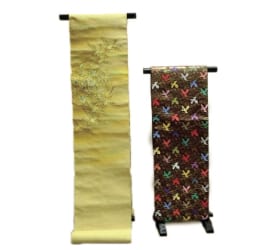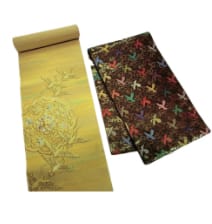A bit of knowledge about textile arts
Vertical (warp) and horizontal (weft) yarns are woven together to make cloth. In “saki-zome” (pre-dyeing) the yarns are dyed before weaving, so that patterns will be defined by the colors; whereas, “ato-zome” (post-dyeing) involves dyeing the woven cloth to produce patterns. The most common form of plain-woven cloth is composed by alternately interweaving individual warp and weft yarns, with habutae, tsuzure (tapestry weave) and tsumugi (pongee) being good examples, while others include aya-ori (twill weave), shusu-ori (satin weave) and mojiri-ori (Leno weave). Weaving follows these rules, or variants of them.

Jacquard weave (mon-ori)
Textiles are broadly divided into plain weaves or patterned weaves.
There are many methods for producing patterns, like plain weaves, such as kasuri (splashed patterns), with the pattern produced by the warp yarn, and enuki yarns (figure wefts) and nuitori-ori (raised weave brocade) that employ wefts to create patterns. Moreover, to produce really complicated weaves, someone came up with the sorahikibata (draw loom), with a frame on top of the takabata (floor loom) to seat a weaver who would work in sync with the floor loom weaver to raise the warp yarn and add colored yarns to either the warp or weft. This was the loom contrivance used before Jacquard looms were imported into Japan in the 19th century.

Nishijin Textiles
The name “Nishijin” (west camp) refers to the camp position of the warlord Yamana Sozen during the Onin War (1467-1477). After the war, weavers returned to that area to restart the Kyoto style of weaving. And, as those weavers, known as the “Otoneri-za” were relatives of the Hata clan, their workshops produced the silks that were directly under the control of the shogun’s family, which boosted the fortunes of Nishijin as a bastion of weaving. In present day terms, Nishijin is marked off as being in Kamigyo-ku and Kita-ku, with the northern border being Kitaoji-dori, Imadegawa-dori to the south, Senbon-dori to the west and Horikawa-dori to the east. Tsuzure-bata (hand looms) are used to weave tsuzure-ori (figured brocade) – yet, at Nishijin, once the shuttle is used to weave the warp, the weaver uses his/her nails to draw in the weft to create the pattern in a unique technique known as “tsumekaki-hontsuzure-ori” (fingernail weaving). Famed textiles to come out of Nishijin are the obi (sashes) made for kimonos and doncho (stage drop curtains). Thus, sartorially and theatrically, the profound sensitivity and vivid hues of Nishijin’s textiles gloriously adorn many people and stages. Indeed, Nishijin textiles can be found on many of the championship pennants in high school baseball as well as the big tapestries (or reproductions) gorgeously adorning the rear ends of traditional floats in the Gion festival.
Regional textiles
Other regions of Japan also weave their own dyed textiles that reflect the climate in their areas and the materials available to them. Bashofu, the abaca-cloth of Okinawa is made from itobasho (Musa liukiuensis), with the Ogimimura Kijoka abaca-cloth of (an important intangible cultural asset) named with kudzu-cloth from Shizuoka prefecture and shina-cloth from Yamagata prefecture as the three famed ancient textiles of Japan.Before commercial distribution became a reality, rural housewives would busy themselves with spinning, dyeing and weaving during the fallow months of winter to make family clothing. Then, in the Edo period, when silk became more common, such housewives would take their spun yarn to dyers in town. And, when the wish was to have the kasuri (splashed patterns) on finished kimonos, small areas of the cloth were tied to prevent dye seeping in during the dying process (resist).
Again, the three famed kasuri textiles of Japan are Kurume-kasuri of Fukuoka prefecture, Iyo-kasuri of Aichi prefecture and Bingo-kasuri of Hiroshima prefecture, with all of them being kongasuri, or dark- blue cloth with white splash patterns.
The three major Jofu (a fine linen spun from hemp yarn) brands are Miyako-jofu from Okinawa, Oumi-jofu from Shiga prefecture and Echigo-jofu from Niigata prefecture, with the latter an important intangible cultural asset. And, a visit to facilities like the Orinasukan Handmade Fabrics Museum will provide you with the opportunity to see textile history from across the entire country – that is Kyoto for you!
Photo: Nishijin obi sash (Nishijin Textile Center)